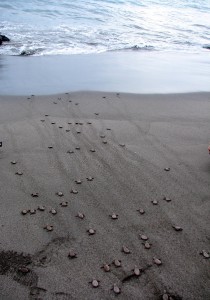Turtle Protectors Surprised by Green Visitor
The people charged with protecting some of Hawaii’s most delicate creatures – Hawaiian hawksbill turtle hatchlings – had a surprise this past year.
The volunteers who monitor nesting activities at various remote Big Island beaches found in July that one of the females was another species, a green sea turtle.
While they are considered threatened, green sea turtles have dramatically increased in numbers in recent years, and can often be seen basking on beaches or grazing on seaweed just off the shore.
Green sea turtles, or honu in Hawaii, usually nest at French Frigate Shoals in the Northwestern Hawaiian Islands. This was the first time honu nesting has been observed on the Big Island, although they are known to have nested on all of the other main Hawaiian Islands except Niihau.
Will Seitz, head of the Hawaii Island Hawskbill Turtle Recovery Project based at Hawaii Volcanoes National Park, said the honu was first observed false nesting at the park’s Halape beach. A week later, the honu had traveled around the tip of South Point to Pohue Bay – a 52-mile journey – where she nested successfully.
In September, 40 baby honu made their way to the ocean, Seitz said.
During the 2010 nesting season the turtle volunteers had observed yet another species, an olive ridley sea turtle, nesting on a remote beach along the Big Island’s southwest coast. That was the fourth time an olive ridley was known to nest on the island, including one that occurred at Hilo’s Bayfront.
The main subject of the recovery project, hawksbills or honu‘ea, had another good season in 2011. Along with observing the first daytime nesting in the project’s history, volunteers monitored 29 nests from which an estimated 3,000 hatchlings made their way to the sea.

Honu‘ea hatchlings make their way to the sea after digging out of their nest at Halape. Photo courtesy of HIHTRR.
That means the project has helped protect an estimated 89,000 hatchlings since it began 22 years ago.
Before then, very few if any honu‘ea hatchlings made it to the ocean because of predation by feral and other animals, or physical obstacles that prevented them from reaching the water.
In some cases they might not even have had a chance at freedom, as mongooses and other animals have been known to dig up nests to eat the eggs.
Since 1989, volunteers have patrolled the coast during the nesting season lasting from May through December, protecting nests and watching at night for more nesting activity. After a female digs a hole above the high tide mark and lays her eggs, the volunteers check her flippers to see if she already carries the project’s tag.
The volunteers placed tags on five new females this year, continuing a trend that has been occurring since 2005. After seeing an average of only two untagged females annually in the previous five years, project workers began encountering more turtles that year.
Since 2005, the number of untagged females has averaged about seven each year.
There has been some conjecture that the jump is the result of hatchlings protected by the project years ago maturing and returning to nest.
That theory is based partly on the fact that hawskbills in other parts of the world – whose numbers are declining dramatically – are believed to reach breeding age in 20 to 25 years.
“It’s possible that some of these females may have been hatchlings here, but it’s hard to prove,” Seitz said.

A baby honu‘ea crawls out of its nest at Pohue Point on the southwest coast of the Big Island. Photo courtesy of HIHTRR.
Even if it makes it to the water, a baby turtle’s life is a perilous one. Birds, sharks and other ocean predators take a huge toll on hatchlings, and it’s thought that perhaps only one in a thousand may survive to reproduce.
Hawaiian hawksbills are among the rarest of turtles, with only about 120 known females. Most of those have been tagged at Big Island beaches, although a few have been found nesting on Oahu, Molokai and Maui.















